Cedar trees, with their towering grace and timeless beauty, have an allure that captivates the senses. Imagine being able to cultivate these majestic trees right in your own backyard, watching them flourish under your care. Well, here’s a secret that Mother Nature whispers to the green-thumbed dreamers: you can propagate cedar trees from cuttings and embark on a rewarding journey of horticultural wonder.

Unveiling the Cedar Magic
A Symphony of Types
Before you dive into the propagation process, let’s get acquainted with the stars of our show. Cedar trees come in various types, each with its unique character. There’s the Eastern Red Cedar, flaunting its rustic charm; the Western Red Cedar, a symbol of resilience; the delicate White Cedar, exuding elegance; and the grand Atlas Cedar, hinting at far-off lands. Each type has its distinct personality, waiting to grace your landscape.
The Cuttings Conundrum
Now, why bother with cuttings, you ask? Well, darling, propagating from cuttings lets you skip a few steps in the cedar-growing tango. You see, it’s like getting a head start in a race. The cuttings are essentially snippets of a cedar branch that you nurture into full-fledged trees. It’s like planting a tiny hope and watching it grow into a testament of your love for nature.
Prelude to Propagation
Gathering Your Arsenal
Picture this: you, armed with a pair of trusty pruning shears, a sprinkle of rooting hormone, and an army of growing containers. It’s time to get your hands dirty! You’ll need a mix of sterilized potting soil (think of it as a cozy home for your future cedars) and some clear plastic bags to create a mini greenhouse.
The Art of Selection
Cedar cuttings are like choosing the perfect outfit – you want healthy, well-dressed candidates. Look for branches that are neither too young nor too old, ideally something in between – a sweet spot known as semi-hardwood cuttings. These are the branches that aren’t too fresh but haven’t gone all creaky either.
Timing is Everything
Remember that old saying about timing? Well, it’s not just for comedians. If you want your cuttings to strike a chord and root with joy, you’ll need to choose the right season. Spring and early summer are your jam for softwood cuttings, while late summer to fall is prime time for those semi-hardwood cuttings.

Crafting Your Cuttings
A Ballet of Pruners
Now, here’s where the magic happens. Picture yourself delicately pruning your chosen branches, snipping away excess leaves, and giving your cedar cuttings a stylish haircut. This isn’t just about aesthetics – it’s about making sure your cuttings put all their energy into rooting.
The Secret Elixir
Ah, the rooting hormone – nature’s cheat code for growth. Think of it as a motivational speech for your cuttings, encouraging them to grow roots faster. Just a gentle dip of your cuttings’ ends into this magical elixir, and you’re all set.
The Rooting Ritual
The Right Digs
Your cuttings need a cozy home to call their own. Fill your growing containers with the sterilized potting mix, like a soft bed for your baby cedars. Nestle your cuttings in there, and don’t forget to mist them with a spritz of water. It’s like giving them a little spa day.
Environment is Key
Now, imagine creating the perfect ambiance for a cedar cuttings party. You’ll need just the right amount of light, warmth, and humidity. Hang a “Welcome Home!” sign for your cuttings by placing a clear plastic bag over them. This creates a mini-greenhouse that keeps humidity levels just right.
Water, Water, Not Too Much
Think of your cuttings as sponges – they like a little moisture but not a soaking. Water them enough to keep the soil damp, but not swimming. It’s a delicate balance, like mastering a tightrope act.
Nurturing New Life
The Patience Dance
Ah, patience – the virtue of a green thumb. As your cuttings embark on their rooting journey, you’ll play the waiting game. Keep a watchful eye, make sure they’re cozy, and trust the process. It’s like watching a story unfold, chapter by chapter.
Troubleshooting Tango
Now, not every story is without its twists. You might encounter mold or pesky pests trying to crash your cedar cuttings’ party. But fear not! A dash of fungicide or some gentle persuasion will keep your cuttings dancing.
The Grand Debut
Signs of Success
Ah, the suspense! How will you know when your cuttings have sprouted roots? Look for little green shoots popping out and gentle tugs that hint at newfound stability. It’s like witnessing the first steps of a tiny explorer.
Transplant Tango
When your cuttings have grown a strong root system, it’s time for the grand entrance. Pick a cozy spot in your garden, dig a hole, and gently transplant your young cedars. It’s like introducing them to a new neighborhood, where they’ll grow and flourish.
A Symphony of Satisfaction
Nature’s Applause
As your propagated cedar trees sway in the breeze, you’ll bask in the applause of Mother Nature. It’s a symphony of life, a tale of growth, and a testament to your nurturing spirit. You’ve taken a humble cutting and nurtured it into a magnificent cedar tree.

Conclusion: A Journey of Growth
So, there you have it – a guide to propagating cedar trees from cuttings that even a budding horticulturist can follow. From the delicate snip of a cutting to the triumphant transplant, you’ve embarked on a journey of growth, patience, and wonder. As your cedar trees thrive, you’ll know that you’ve not only enriched your garden but also your soul. Happy propagating, dear gardener, and may your cedar forest flourish! 🌱🌲





